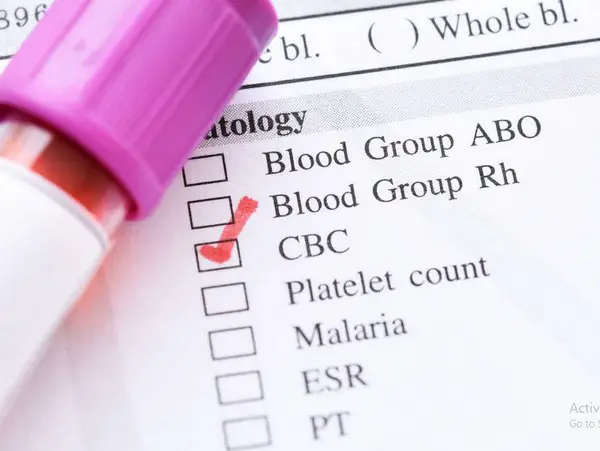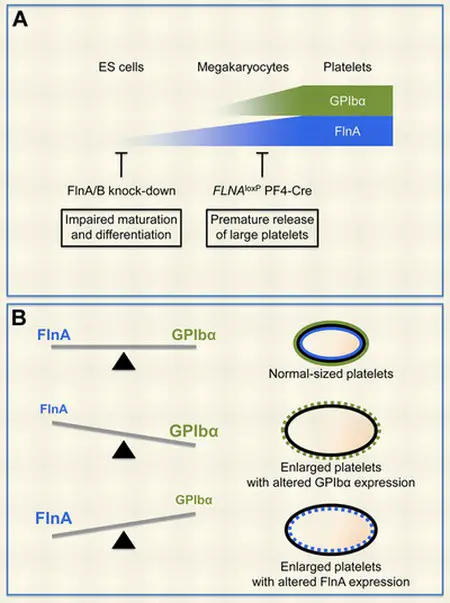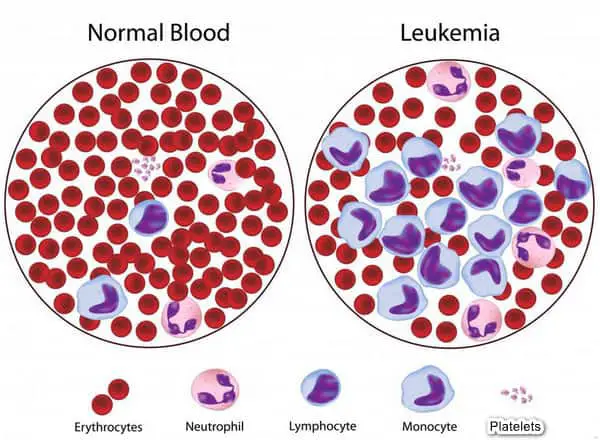What is MPV Blood Test
The human blood consists of various components such as the red blood cells, white blood cells, and platelets. A routine blood work is ordered by the doctor to check for an overall health condition, especially if the patient is exhibiting signs and symptoms of health problems.
A complete blood count (CBC) is one of the batteries of tests the doctor used to detect any abnormalities in the body. The complete blood count is an umbrella term for a series of blood test. One of the components of CBC is the MPV test. (1, 2, and 3)
Platelets; a component of the blood also called thrombocytes are the blood clotting factor of the body. They play important roles such as:
- Slowing down blood loss
- Promote healing
- Prevent infection (3)
Platelets/thrombocytes are produced in the bone marrow by megakaryocytes (large precursor cells).
The platelets are pieces of megakaryocytes. Ideally, young platelets are big in size and older platelets are small.

Picture 1: A mean platelet volume test is a part of the routine CBC (complete blood count) test.
Photo Source: medicalnewstoday.com

Picture 2: Image of platelets (graphic)
Image Source: hearstapps.com

Picture 3: A comparison image between a normal platelet size and an enlarged platelet.
Image Source: bloodjournal.org
What is an MPV blood test?

Picture 4: A mean platelet volume in a patient with a normal blood and a patient with leukemia.
Image Source: wisegeek.com
An MPV blood test stands for Mean Platelet Volume. It measures the average size of the platelet. What are platelets? They are small blood cells that prevent blood loss through the formation of a blood clot.
If there is an abnormality in platelet, it could indicate a possible health problem such as bleeding disorders. A severe abnormality in the MPV test result is used by the doctor to conduct additional testing such as bone marrow biopsy. (3, 4)
How to perform an MPV test?
A procedure called complete blood count (CBC) is used to detect the mean platelet volume. A phlebotomist wraps a tourniquet around your arm to visualize and engorge the vein.
A thin needle is inserted into the vein to draw ample amount of blood, which will be sent to the laboratory for further examination. (4, 5)
What is the purpose of MPV test?
The procedure is specially requested by the doctor if he/she suspects symptoms of blood disorders.
Signs and symptoms that could lead to possible blood disorders include:
- Prolonged bleeding as a result of injury, minor cut, and nose bleeding
- Abnormal red spots or purplish spots on the skin
- Unexplained bruising (5)
Mean platelet volume in respect with platelet count
- High MPV/low platelet count – It happens when the platelets are destroyed and there are various factors responsible for it such as infection, antibodies, and toxins. A perfect example is idiopathic thrombocytopenic purpura; a platelet deficiency secondary to platelet destruction. The exact cause is unknown.
- High MPV/high platelet count – It occurs when the bone marrow produces too many platelets which are common in patients with cancer or genetic mutation.
- High MPV/normal platelet count – It occurs in people with chronic myelogenous leukemia (cancer) and hyperthyroidism. (5, 6, and 7)
MPV blood test high
If the mean platelet volume is high, it means that your platelet is higher than the average, which means that you are producing too many platelets.
However, if your MPV is high and your platelet count is low, it could indicate a possible bone marrow disorder (rapidly producing platelets) leading to the destruction of the older platelets. (4, 6)
A high MPV can be linked with the following:
Cancer
A high MPV is linked with platelet activation as a result of an encounter of platelets to tumor by-products.
If you have a family history of cancer or exhibiting signs and symptoms of cancer (abnormal changes in the breast, skin abnormalities, an abnormal lump under the skin, change in bowel habit, feeling weak, night sweat, unusual bleeding, and abnormal changes in bowel habit) your doctor might need to perform additional test to confirm the diagnosis.
On the other hand, if you have cancer and your mean platelet volume is high, it means that the cancer cells have already metastasized or spread to other body parts.
It signals a reduced survival rate, especially in patients with lung cancer, colon cancer, ovarian cancer, cancer of the stomach and kidneys, pancreatic cancer, endometrial cancer, and breast cancer.
Other possible conditions caused by a high mean platelet volume are heart-related disease, hyperthyroidism, diabetes, high blood pressure, vitamin D deficiency, diabetes, atrial fibrillation, stroke, and preeclampsia. (6, 7, 8, and 9)
MPV blood test low
An abnormally low mean platelet volume means that y our platelets are smaller than the average. They are old platelets, which means that the bone marrow has trouble producing new platelets. With the interpretation of other blood level parameters, a low mean platelet volume could indicate the following:
- Inflammatory bowel disease such as ulcerative colitis and Crohn’s disease.
- Exposure to some type of drugs that could harm the cells (cytotoxic medication); usually drugs used for chemotherapy.
- Bone marrow hypoplasia ( a disease caused by a decreased production of blood cells)
- Aplastic anemia (2, 6, 9, and 10)
Bottom-line
The mean platelet volume test is one of the parameters checked in a routine blood test. The mean platelet volume measures the size of the platelet. It is different from platelet count but is closely related to it.
A high MPV may have a low platelet count and the other way around. However, a high MPV does not always mean that there is an abnormality in the body.
A low MPV does not always suggest abnormalities. Which is why it is important to take a look at other blood parameter readings so as to check whether or not there is indeed an abnormality or not.
More so, there are several factors that could affect the result of mean platelet volume. These include:
- Performing strenuous physical activity
- Living in high altitudes
- Use of certain drugs such as birth control pills
- Menstrual cycle (4)
- Pregnancy
- Genetic defect (rare case)
Frequently Asked Questions
Q1. What does it mean when your MPV is high?
If the MPV level is high, it means that the platelets are larger than the usual. What is its significance? Well, it is an indicator that your body is producing too many platelets. As you know, too much of anything could have a health implication.
Q2. What is a normal MPV level?
The normal MPV level ranges between 7.5 fl and 12.0 fl.
Q3. What causes low MPV levels in blood?
There are many possible reasons why the level of MPV is low but usually, if it is associated with a low platelet count, it could suggest problems in the bone marrow such as aplastic anemia. On the other hand, if the MPV level is low but the platelet is high, it signals an underlying inflammatory disease, infection, or cancer.
Q4. What level of platelets is dangerous?
If the platelet count falls below 10,000, it is an extremely dangerous situation. You could be at risk for internal bleeding.
Q5. How do I lower my MPV?
There are many ways to lower MPV and this includes:
1. Eating the right foods such as vegetables, fruits, whole grains, and low saturated fat foods.
2. Exercise regularly. Spend at least 30 minutes a day doing moderate physical activities.
3. Avoid vices such as smoking and drinking.
4. Maintain a healthy weight.
Q6. Can stress cause high MPV?
Stress can cause havoc to one’s health. Stress and anxiety cause a rise in platelet volume, specifically mean platelet volume which corresponds to the size and activity of the platelet.
Q7. Is high MPV good?
A high MPV reading is linked to the activation of the platelet, which takes place when platelets encounter a byproduct of a tumor. However, it does not necessarily mean that you have cancer if your MPV reading is high. Additional testing is needed, especially if you have a family history of cancer.
Q8. How do you increase MPV?
You can naturally increase MPV count by consuming foods known to boost platelets such as those high in vitamin C, D, K, and B12. An increased in folate-rich foods can also help increase the level of the platelet.
Q9. How do you calculate MPV on a CBC?
To calculate MPV on a routine complete blood count, you have to divide PCT or plateletcrit by the total number of platelets.
Q10. Do low platelets make you feel tired?
In most cases, a low platelet does not exhibit any symptoms, especially if the deviation is only mild. However, for moderate to severely low platelet count, the patient could experience some sort of discomfort along with other symptoms like:
– A feeling of fatigue/easily gets tired
– Easily or excessively gets bruised
– Appearance of petechiae or small reddish rash which indicates superficial bleeding
– Jaundice or yellowing of the skin
– Prolonged bleeding cuts
– Continuous bleeding of the gums and nose
– Presence of blood in the urine or stool
– Heavy menstrual bleeding
– Bleeding that doesn’t seem to stop
Q11.What is the most common cause of low platelet count?
A low platelet count could be a result of many factors, but most of the time it is linked to autoimmune diseases like rheumatoid arthritis and lupus. It is an immune response wherein the immune system mistakenly attacks and destroys the body’s own platelets.
Q12. How low is too low platelet count?
A platelet count that is lower than 150,000 is considered thrombocytopenia. However, if you talk about too low platelet count, we are referring to a reading that is below 10,000. It is a severe state and warrants immediate medical attention.
Q13. Do high platelets always mean cancer?
A platelet that is high in number is referred to as thrombocytosis which is usually related to cancer, specifically breast cancer, ovarian cancer, lung cancer, gastrointestinal cancer, or lymphoma. However, further diagnostic procedures have to be done to confirm the diagnosis. Aside from the possibility of cancer, there are other conditions that could cause an abnormal increase in platelet.
Q14. What infections cause a high platelet count?
Other conditions that cause an increase in platelet count include iron deficiency anemia, hemolytic anemia, inflammatory or infectious diseases like tuberculosis, inflammatory bowel disease, and connective tissue disorder, and post-splenectomy.
Q15. How high is too high for platelets?
If the platelet count exceeds 450,000 cells per microliter that are considered too high, which in the medical field called thrombocytosis.
Q16. What is a normal platelet count for a woman?
The normal platelet count varies per gender. In women, the average platelet count ranges between 157,000 and 371,000 per microliter of blood.
Q17. What is a normal platelet distribution width?
The platelet distribution width is used as a parameter for checking the variation of platelet size. The normal distribution width of the platelet is 8.3% to 56.6%.
Q18. What is MCV in a blood test?
MCV is the mean corpuscular volume in the blood which can be found in the red blood cells, white blood cells, and platelets. What it indicates is the measure of the average size of the red blood cells or erythrocytes.
Q19. What foods to avoid if you have low platelets?
If you have a low platelet count, it is not only important to know what foods to eat but also know what foods to avoid. These include:
– Hydrogenated trans fats
– Canned and frozen products and leftovers
– Highly processed foods
– White flour and white rice
– Sugary products
– Meat
– Dairy products
– Alcoholic beverages
– Foods that can alter the body’s blood clotting ability
Q20. What medications cause low platelets?
There are certain drugs that cause your platelet to go down such as penicillin, quinine, ranitidine, furosemide, sulfonamides, and gold used for treating arthritis.
Q21. Can vitamin D deficiency cause a high platelet count?
A deficiency in vitamin D can have a direct effect on platelet count. It can increase platelet volume which increases the risk of having cardiovascular-related diseases.
Q22. Can anemia cause high platelets?
There are several conditions that can cause a spike in platelet count and some of them are cancer, anemia, underlying infection, and inflammatory-related conditions.
Q23. What do neutrophils mean in a blood test?
Neutrophils are army cells, a type of white blood cell, responsible for helping damaged tissues heal and resolve infections. If there is an infection, injury, or stressful conditions, the number of neutrophils rises. However, their number decreases in response to genetic conditions, chronic infections, and side effects of drugs.
References
- https://www.verywellhealth.com/mean-platelet-volume-797202
- https://en.wikipedia.org/wiki/Mean_platelet_volume
- https://www.healthline.com/health/mpv-test
- https://www.medicalnewstoday.com/articles/322726.php
- https://medlineplus.gov/lab-tests/mpv-blood-test/
- http://www.bloodjournal.org/content/116/21/3172?sso-checked=true
- https://labtestsonline.org/tests/platelet-count
- https://www.lybrate.com/lab-test/mean-platelet-volume
- https://www.karger.com/Article/FullText/445579
- https://www.babymed.com/laboratory-values/mean-platelet-volume-mpv-whole-blood-during-pregnancy
